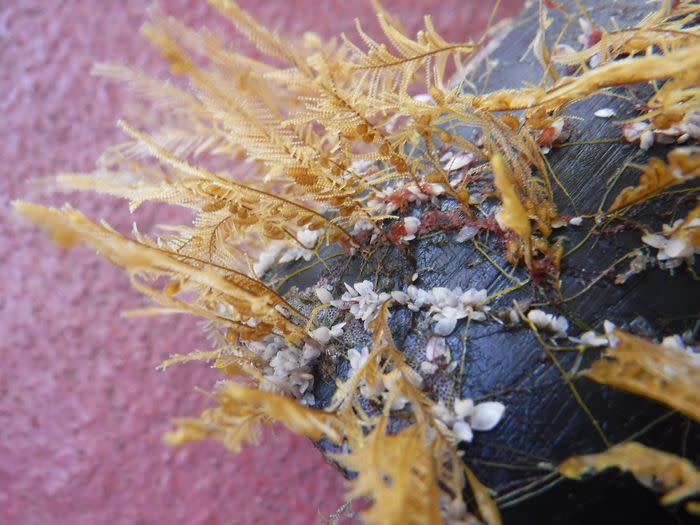Unexpected Species Are Colonizing Rafts of Plastic Debris in the High Seas
Plastic pollution is creating mobile habitats for species once confined to the coasts. What could possibly go wrong??

The Ocean Cleanup in coordination with Smithsonian Institution
Coastal hydroid and gooseneck barnacles living on floating plastic collected in the North Pacific Subtropical GyreIt used to be that coastal species lived in coastal habitats. This makes sense. But now, a new study describes a surprising number of coastal marine invertebrate species thriving in floating communities in deep ocean waters. What's their secret? They are colonizing ever-expanding rafts of plastic debris.
The study was led by researchers from the Smithsonian Environmental Research Center (SERC) and the University of Hawai‘i (UH) at Mānoa. They found a diverse range of taxonomic groups of coastal species in the eastern North Pacific Subtropical Gyre on over 70 percent of the plastic debris they examined. Not only that, but the debris carried more coastal species than open ocean species.
Related:The Great Pacific Garbage Patch: Overview, Impacts, and Solutions
“This discovery suggests that past biogeographical boundaries among marine ecosystems—established for millions of years—are rapidly changing due to floating plastic pollution accumulating in the subtropical gyres,” said lead author Linsey Haram, research associate at SERC.
These floating communities, or “neopelagic communities,” in deep ocean waters were only recently discovered by scientists. To better understand the ecology of floating marine debris, SERC and UH Mānoa formed a multi-disciplinary Floating Ocean Ecosystem (FloatEco) team.
For this study, the FloatEco team looked at 105 plastic samples collected by The Ocean Cleanup during their 2018 and 2019 expeditions in the North Pacific Subtropical Gyre, which occupies most of the northern Pacific Ocean.
“We were extremely surprised to find 37 different invertebrate species that normally live in coastal waters, over triple the number of species we found that live in open waters, not only surviving on the plastic but also reproducing,” said Haram.
“Our results suggest coastal organisms now are able to reproduce, grow, and persist in the open ocean—creating a novel community that did not previously exist, being sustained by the vast and expanding sea of plastic debris,” said co-author Gregory Ruiz, senior scientist at SERC. “This is a paradigm shift in what we consider to be barriers to the distribution and dispersal of coastal invertebrates.”
While the idea of new communities making use of plastic islands on the high seas has all the makings of a DreamWorks animated feature, the reality is not so rosy. Rather, the new study details a new anthropogenic impact on the ocean, documenting the scale and potential consequences that were not previously known. Namely, a new route of transportation for potentially harmful species.
Related:10 Invasive Species That Changed the World Forever
“The Hawaiian Islands are neighbored in the northeast by the North Pacific garbage patch,” said Nikolai Maximenko, co-author and senior researcher at the UH Mānoa School of Ocean and Earth Science and Technology. “Debris that breaks off from this patch constitutes the majority of debris arriving on Hawaiian beaches and reefs."
"In the past, the fragile marine ecosystems of the islands were protected by the very long distances from coastal communities of Asia and North America," Maximenko adds. "The presence of coastal species persisting in the North Pacific Subtropical Gyre near Hawai‘i is a game changer that indicates that the islands are at an increased risk of colonization by invasive species.”
The study, "Extent and reproduction of coastal species on plastic debris in the North Pacific Subtropical Gyre," was published in Nature Ecology and Evolution.

